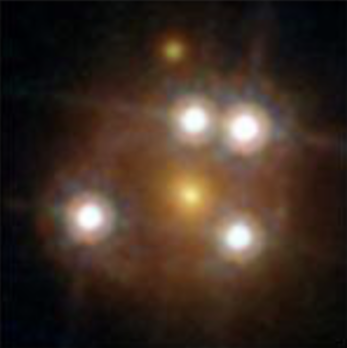H0LiCOW XII. Lens mass model of WFI2033−4723 and blind measurement of its time-delay distance and H0.

Following our work on the four previous H0LiCOW lenses, in this paper we conduct a comprehensive modeling of the quadruply lensed quasar WFI2033−4723, discovered by Morgan et al. (2004), and shown in Figure 1. Our work supersedes the early modeling of this system by Vuissoz et al. (2008), and is based on new imaging data with HST, new kinematics data, as well as newly measured time delays presented in Bonvin et al. 2019, and new environmental data, presented in Paper XI.
Our modeling follows the approach outlined in our previous H0LiCOW work, but is customized to account for the complexities shown by WFI2033−4723. As before, we conduct our modeling in a blinded approach, so as not to be affected by experimenter bias. We model the main lensing galaxy with a singular power-law elliptical (SPEMD) mass distribution as well as a composite dark-matter + baryonic components mass distribution, to mitigate the effects of profile degeneracy. These models are successful in reproducing the features observed in the HST data, as shown in Figure 2.

Accounting for the environment of the lens in order to mitigate the effects of the mass-sheet degeneracy is particularly challenging. Figure 3 shows three nearby galaxies which we flag as having potentially significant impact on the potential of the main lens, as well as a very near light component marked with X. One of these galaxies is at a different redshift from the main lens, making it necessary to employ a multiplane lensing analysis. In addition, we show that WFI2033−4723 is located in a relatively overdense environment, as Paper XI identifies two galaxy groups at different redshifts which are large enough to potentially impact the modeling. In addition to explicitly modeling these structures, we further develop our technique of inferring the external convergence to the lensing system based on the results of the Millennium Simulation, by specifically accounting for our spectroscopic incompleteness when accounting for galaxies potentially associated with the galaxy groups.

The main result of our work is that we infer the time-delay distance to our lens to be ~4800 Mpc, with a precision of 6.6%, after accounting for all known sources of error and various systematics (Figure 4). This translates to a direct measurement of the Hubble Constant of H0=71.6+3.8-4.9 km/s/Mpc in a flat LambdaCDM cosmology. This result is statistically combined with those resulting from the other H0LiCOW lenses in Paper XIII.
